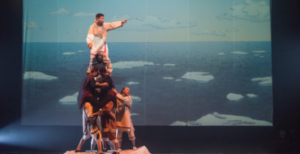The first time I saw Picasso’s ‘Guernica’ was in my grade 8 Socials Studies class. Our teacher showed us a tiny photo. Blurry and defrauded by the shortcomings of a geriatric overhead projector, the iconic monochrome madness seemed to my adolescent eyes little more than squiggles. But last year, when I saw the real thing at Madrid’s Reina Sofia Art Gallery, I was speechless. I’ll not know whether it was my decade’s worth of growth as an art appreciator or just the staggering enormity of the painting, but when I witnessed ‘Guernica’ this second time I could truly feel the horror of its subject matter.
Picasso’s modernist masterpiece depicts one of the previous century’s most tragic moments. And it was a century replete with tragedy. On April 26, 1937, amidst the throes of the Spanish Civil War, Nazi Germany’s Luftwaffe, the thugs of Franco’s Fascist party, bombed the Basque town of Guernica. It was a savage strike upon civilians that all but erased their town entirely. For that summer’s World’s Fair in Paris, Picasso was commissioned to create a work in commemoration of the mass homicide. The piece epitomizes his Cubist style and remains one of the defining, if hauntingly evocative, images of this war-torn period in Western history.
This year at the Fringe Festival, writer Erika Luckert and director Jon Lachlan Stewart consider this historical event and explore this major work of art with a play of the same name— a courageous move.
Set against a low-lit black and white backdrop reminiscent of its ancestral artwork, Guernica (the play) tells the fractured story of an artist’s exasperating pursuit of connection and authenticity. We watch as he curiously encounters townsfolk mired in myriad psychological encumbrances of the kind that aren’t done justice by calling their bearers ‘townsfolk.’ Though fiercely intrigued, the Picasso figure is by and large silent as he meets and observes these characters: The shiftily discerning fruit vendor, the precocious and browbeat young girl, the unprepared expectant father, the proudly obsequious mother and the aloof whore. (The standout performer is Byron Trevor Martin as Carlos, the father-to-be). Luckert’s Guernica is populated by something ominous, something shameful perhaps and certainly something not quite at peace with itself. I wondered why though.
Luckert seems to resuscitate the bombing victims bound up with all their plaguing complexities as if to demonstrate how just such an exercise is mandated by the duties of the artist. The process of the artist character, whom Luckert calls “the candlebearer,” involves his wide-eyed surveillance of the other characters. (Ben Stevens, whose tilt-headed arch-backed curiosity took a slow toll on me, played this role). The townspeople entwine and crisscross and pontificate and stumble around. The candlebearer follows them and perseveres to understand their deepest hopes, dreams, fears, indignities and sins. This will enable him to illuminate their experience on the canvas.
But what about the horrific and devastating climax of that experience?
The main message of the play seems to be that we ought not to forget that these people, the victims, dealt with richly complex problems and felt the burdens of society just like anyone else. They were real. The bombings were a mere, albeit a final, interruption of their shame-laden, tradition-oppressing and self-absorbed lives. This was the main point that I felt a bit condescended to. Furthermore, that all Picasso had to do was simply hypothesize about these people, their daily struggles, their secret insecurities, in order to unearth the truthfulness needed to represent the act of terrorism that killed them. In this vein, I thought the play came across presumptuous at times.
Granted, the script, though laudably ambitious, was questionable. Its realization however, was thought provoking. Stewart had the actors form impressive tableaus at appropriate moments, mimicking the painting. Often the blocking reflected Picasso’s own Cubist vision, with stark subversions of realism and unexpected deployments of space and light. In fact, the whole scenic structure and movement of the play exemplified the Cubist sense of multi-directionality and its sundry and simultaneous points of view. Luckert and Stewart tackled the notion of perspective well and edified intriguing, though nebulous, views on art and aesthetics.
Ultimately, Guernica addressed the painting more adeptly than it did the terrorism. I recommend you see it for its stimulating visuals and the potent directorial choices but, just know, you don’t have to conform when the play implores you get atop its high horse’s saddle.
Click here for Guernica Showing Times.









